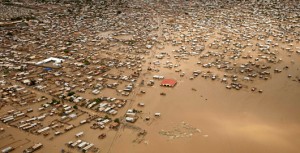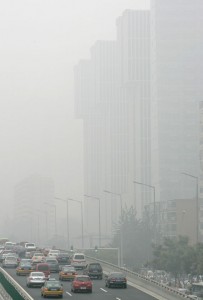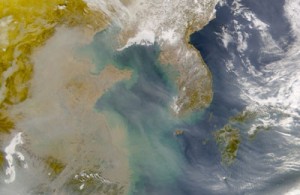Within the political process, power usually rest in the hands of those with power – often in the form of wealth. Thus far in global climate negotiations, we have focused primarily on Annex I (developed nations) and used them as a measurement of what other nations should do. Unfortunately, developed nations often have the least to lose and for this reason I believe small island states and economically developing countries deserve the most attention at the United Nations Framework Convention on Climate Change Conference of the Parties (UNFCCC COP 15) in Copenhagen, Denmark.
In 2005, the World Resources Institute published a report titled “Navigating the Numbers: Greenhouse Gas Data and International Climate Policy,” with the goal of providing data to facilitate international climate change dialogue among policy makers. This seems logical since the goal of this organization – as stated on their website – is to, “Go beyond research to find practical ways to protect the earth and improve people’s lives.”
Hence, I found it odd when they chose to end chapter 2 – titled GHG Emissions and Trends – of their report by stating that, “Successful mitigation agreements need not be global, in the sense of engaging all countries. The least developed countries & small island developing states…are not critical to GHG mitigation efforts” (16). How can an organization devoted to improving people’s lives exclude certain groups?
To answer this question, I first explored the conditions of small island developing states and developing countries as it relates to climate change. Currently, these developing nations are experiencing more frequent and stronger storms, shoreline erosion, damage to agricultural crops, sever food and water shortages, along with a host other weather-related issues

Courtesy of Association of Small Island States
according to the Fourth Assessment Report of the Intergovernmental Panel on Climate Change. If attention is not given to these nations it is likely conditions will intensify and many of these areas will become uninhabitable, as this image from the Alliance of Small Island States shows.
So why then does nations often go ignored despite lobbying groups like the Alliance of Small Island States?
The answer is money, the root of all evils. In the case of the World Resources Institute, they are funded by the U.S. Environmental Protection Agency and for that reason take a western and specifically United States centric approach.

Courtesy of Association of Small Island States: This image is what will permanently become of these regions without immediate action
On a broader scale, wealthier nations attract more attention and for that reason the past UNFCCC Conferences have focused on their actions solely. I would argue that the driving force of climate change policy needs to be centered on the needs of small island states and economically developing countries because they have the most at stake. As S. Kelman states in “How Should We Evaluate Policy-Making Process” (1987), “An honest effort to achieve good public policy…[should] take everyone into account, not just one self” (208). Because our past approach has not worked I would suggest we enter into the UNFCCC COP 15 in Copenhagen, Denmark, with a goal of preserving small island states and economically developing countries from extinction.
By transitioning power to these smaller nations – instead of the wealthier nations that are largely responsible for the problem – we can hopefully reach a consensus, something many think is otherwise impossible.
Tags: Small Island States
 Climate change negotiations are the ultimate test of international cooperation. Participating members range all across the economic spectrum, from poor, undeveloped island countries to super powers like the United States and everything in between. In some cases, literally the only thing negotiating members have in common is the fear of the consequences presented by climate change.
Climate change negotiations are the ultimate test of international cooperation. Participating members range all across the economic spectrum, from poor, undeveloped island countries to super powers like the United States and everything in between. In some cases, literally the only thing negotiating members have in common is the fear of the consequences presented by climate change.
Since the developing countries are or will soon become some of the largest emitters in the world, their participation is vital to the success of climate change adaptation plans. However, developing countries like China and India will not commit to environmental restrictions that do not allow them to continue developing and competing in the global economy, particularly not before wealthier countries demonstrate their commitment to seeing the job through.
Even with the efforts undertaken by the EU, until the US proves that it is willing to commit to large changes and take on the same emission (and economic) restrictions as the rest of the world, limiting their economies would put developing countries even farther back in an economic race they are already struggling to maintain. Therefore, it seems unlikely that India, China, and other developing nations will change their stance or make further commitments in Copenhagen. The US is going to have to make its move first, to demonstrate its determination to meet the emission goals set by the UN and convince developing nations to make their own commitments at the next international conference.
Countries to watch:
India refuses to commit to any emission cutbacks before the United States, prioritizing an improved standard of living for its people over limiting its carbon footprint. India’s Environment Minister, Jairam Ramesh, states that there is “no way” India will be committing to any binding emission limits in 2009. However, the country faces a predicted 20% increase in rainfall during their monsoon season, and intense droughts that will threaten their fresh water supply and agricultural productivity.
Video: How Climate Change is affecting Indian Monsoons
China is also resistant to the proposed emission reductions (back to 1990 emission levels by 2050). Since their economy has grown exponentially in a very short time, returning to their emission levels of 1990 would make continued development next to impossible. However China already has some of the worst air pollution on the planet, and although their per capita emissions are relatively low, its enormous population makes China one of the highest overall emitters in the world.
Likewise, Russia says they will refuse to ratify any policy that imposes restrictions on them but not on the US or China. “Should we restrain our development because of them?” noted Prime Minister Vladimir Putin. Since Russia stands to see an increase in water supply and growing season, they are poised to weather climate change much better than many of their neighbors. However they are likely to see a big jump in immigration as the permafrost of Sibera melts and becomes more habitable.
Can all these conditions be met in Copenhagen? Unlikely. There is such a huge variety of circumstances that different countries are demanding that it is all but impossible for one two-week conference to devise a plan to meet them all. It may be that they best politicians can do is get the US to commit to emission cutbacks and cross their fingers that at the next conference, developing countries will be willing to follow the lead of the world’s economic superpowers, the EU and the US.
Developing countries are facing some of the most severe consequences of climate change. They’ve heard the reports and they know the upcoming challenges. The major obstacle is their distrust of the United States. If that obstacle can be overcome at Copenhagen, hopefully logic or simply fear of the consequences of climate change will propel these countries to commit to environmental measures of their own.
Tags: China, climate change, India
The organization of countries I chose from Yasmin and Depledge is the African Group. The African Group is comprised of nations that have similar socioeconomic and climate change related problems facing them. The African Group is different from most groups in that most of its members are also a part of the LDCs (Least Developed Countries). These nations have a chance to interact both as representatives of Africa and the world’s poorest and least developed countries.
The African Group aligns its interests based on others on their continent which are experiencing similar threats to climate change due to their geographic location and weather. The African Group finds its similarities in “poverty, lack of resources, and vulnerability to extreme weather” (Yasmin and Depledge 5). Africa has been notorious for droughts and floods that affect millions of people: these occurrences are likely to increase a direct effect of climate change. Desertification in particular is of great concern to African governments: droughts that turn fertile land to sand or cracked hardened mud result in famine and violent conflict. Conflicts are very often environmentally- or resource-based; take, for example, the current genocide in Sudan, the genocide in Rwanda or the continued political unrest in the Great Lakes region.
One problem that the African Group faces is the language barriers that exist between country representatives. The many dialects make communication difficult. The oil interests of Algeria and Nigeria also clash with the interests of the rest of the African nations.
Another pressing issue that the African Group faces that was not elaborated upon in the article is the growing threat of malaria all over the continent. As some may know, many African cities like Nairobi have been built above the “malaria line”, or where malaria-carrying mosquitoes cannot live. However, because of climate change, this line has been moving steadily upwards, putting many millions of Africans in danger of malaria exposure. The costs of malaria are not only human lives; malarial medicines and prevention techniques are costly to already poor governments.
Tags: African Group, climate change and malaria, malaria line, poverty
 Version:1.0 StartHTML:0000000180 EndHTML:0000005255 StartFragment:0000002365 EndFragment:0000005219 SourceURL:file://localhost/Users/bettu/Desktop/blogging%20assignment2.doc
Version:1.0 StartHTML:0000000180 EndHTML:0000005255 StartFragment:0000002365 EndFragment:0000005219 SourceURL:file://localhost/Users/bettu/Desktop/blogging%20assignment2.doc
Climate change affects virtually every being on Earth today. Even if your country hasn’t (yet) been struck by ecological disasters, chances are you participate in the world economy, consume industrialized goods, or simply breathe the air we share. That means you too should be involved in climate change management. What does that mean? Well, beyond adopting some everyday, small-scale habits, such as recycling, unplugging appliances and other energy-conserving behaviors, you can urge your country representatives to get involved in the international negotiations on climate change. Now once you – and several million people around the world – have done that, it becomes necessary to move from the negotiation stage to the action stage. And that is pretty much where we’re stuck today. The UNFCCC has generated a spectacularly complex system of bureaucracies, including the much celebrated and hugely unsuccessful Kyoto Protocol. In spite of its noble intention, Kyoto failed due to a fairly important reason: lack of compliance.
As the next meeting of the parties who ratified the Kyoto Protocol, the COP-15, draws nearer, issues concerning its continuation after 2012 are being discussed. Among the factors affecting compliance is the implementation of flexibility mechanisms that allow countries to meet their CO2 emissions reductions goals by participating in a trading system. Ideally, this should allow all parties to benefit by either selling reductions they achieved at a low cost (thus turning a profit), or buying them at a lower cost than they would’ve incurred by applying them domestically. The problem is, of course, how to keep this market from the usual market economy abuses. The entire flexibility system would be undermined if the market grew in a direction in which profits would be produced without generating any real CO2 emissions reductions.
As much as this concern should be addressed by tight regulations, it shouldn’t be strong enough to force the elimination of all flexibility mechanisms. We need to remember that the economic and behavioral changes required under the current climate change management plans are not going to be willed into being, they have to be consciously produced. This will only happen if commitment and compliance can be obtained from all communities in the world. In order to make this goal realistic, it is necessary to facilitate mechanisms for countries to cope with unforeseen obstacles, as well as to encourage bi- and multilateral bonds among them. Flexibility mechanisms will yield positive results so long as legally-binding regulations stemming from strong commitment keep them (and the parties in the market) honest.
Tags: climate change, COP15 Resources, Flexible Mechanisms, Kyoto Protocol

“Flexible mechanisms” – Greenpeace.org
One principle established by the United Nations Framework Convention on Climate Change (“UNFCCC”) during negotiations is that parties have “common but differentiated responsibilities”. Controversial as it is in translating this principle into policies, it rightly captures the diverse nature of participating countries. With “differentiated responsibilities”, it naturally follows that “flexible mechanisms” should be included in the next protocol.
This policy takes into consideration the different levels of difficulty it is for a country to cut back on emissions. A very developed country with cutting-edge technology already in place will find it harder to reduce emissions than countries that can replace obsolete and polluting machines with newer technology. In addition, without Emissions Trading, countries that have already met emission reduction target would have no incentives to further cut their pollution. At the end of the day, the total global reduction would more likely suffer.
Through the Clean Development Mechanism (“CDM”), flexible mechanisms allow countries not currently included in Annex B to benefit from reducing emission. For instance, company X in the US, though having cut emission as much as possible, has reached its limit. It can either buy credit on the market or get credit through the CDM. In finding an outsource company in India, of course it has incentive to find a more environmental friendly one. This mechanism creates a competition for outsourcers in India to cut back on emission to attract foreign client companies. As a result, the protocol applied only to Annex B countries now have positive impact on the rest of the world.
Flexible mechanisms underscore the viewpoint of climate change as a global problem, deserving global cooperation and solutions. Through Emission Trading, CDM and Joint Implementation, the policy creates the convention that countries depend on one another to solve their climate problems. Firms in the EU will begin to think of pollution reduction in China as directly beneficial. This is the necessary mindset for achieving environmental neutrality.
Of course flexible mechanisms need more research and modifications over time to be implemented in the most effective way, they should definitely be included in the next protocol for their recognition of global diversity among participating parties in solving climate change problems.
Luan Nguyen
Tags: Clean Development Mechanism, climate change, emission trading, Flexible Mechanisms, joint implementation, Luan Nguyen


Your Comments